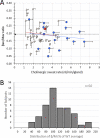Variation in CFTR-dependent 'β-sweating' among healthy adults
- PMID: 35312728
- PMCID: PMC8936459
- DOI: 10.1371/journal.pone.0265432
Variation in CFTR-dependent 'β-sweating' among healthy adults
Abstract
The genetic disease cystic fibrosis (CF) results when mutations in the gene for the anion channel CFTR reduce CFTR's activity below a critical level. CFTR activity = N·PO·γ (number of channels x open probability x channel conductance). Small molecules are now available that partially restore CFTR function with dramatic improvements in health of CF subjects. Continued evaluation of these and other compounds in development will be aided by accurate assessments of CFTR function. However, measuring CFTR activity in vivo is challenging and estimates vary widely. The most accurate known measure of CFTR activity in vivo is the 'β/M' ratio of sweat rates, which is produced by stimulation with a β-adrenergic agonist cocktail referenced to the same individual's methacholine-stimulated sweat rate. The most meaningful metric of CFTR activity is to express it as a percent of normal function, so it is critical to establish β/M carefully in a population of healthy control subjects. Here, we analyze β/M from a sample of 50 healthy adults in which sweat rates to cholinergic and β-adrenergic agonists were measured repeatedly (3 times) in multiple, (~50) identified sweat glands from each individual (giving ~20,000 measurements). The results show an approximately 7-fold range, 26-187% of the WT average set to 100%. These provide a benchmark against which other measures of CFTR activity can be compared. Factors contributing to β/M variation in healthy controls are discussed.
Conflict of interest statement
The authors have declared that no competing interests exist.
Figures





References
-
- Miller AC, Comellas AP, Hornick DB, Stoltz DA, Cavanaugh JE, Gerke AK, et al.. Cystic fibrosis carriers are at increased risk for a wide range of cystic fibrosis-related conditions. Proc Natl Acad Sci U S A. 2020;117(3):1621–7. Epub 2019/12/29. doi: 10.1073/pnas.1914912117 ; PubMed Central PMCID: PMC6983448. - DOI - PMC - PubMed
-
- Collaco JM, Blackman SM, Raraigh KS, Corvol H, Rommens JM, Pace RG, et al.. Sources of Variation in Sweat Chloride Measurements in Cystic Fibrosis. Am J Respir Crit Care Med. 2016;194(11):1375–82. Epub 2016/06/04. doi: 10.1164/rccm.201603-0459OC ; PubMed Central PMCID: PMC5148144. - DOI - PMC - PubMed
Publication types
MeSH terms
Substances
LinkOut - more resources
Full Text Sources
Medical

